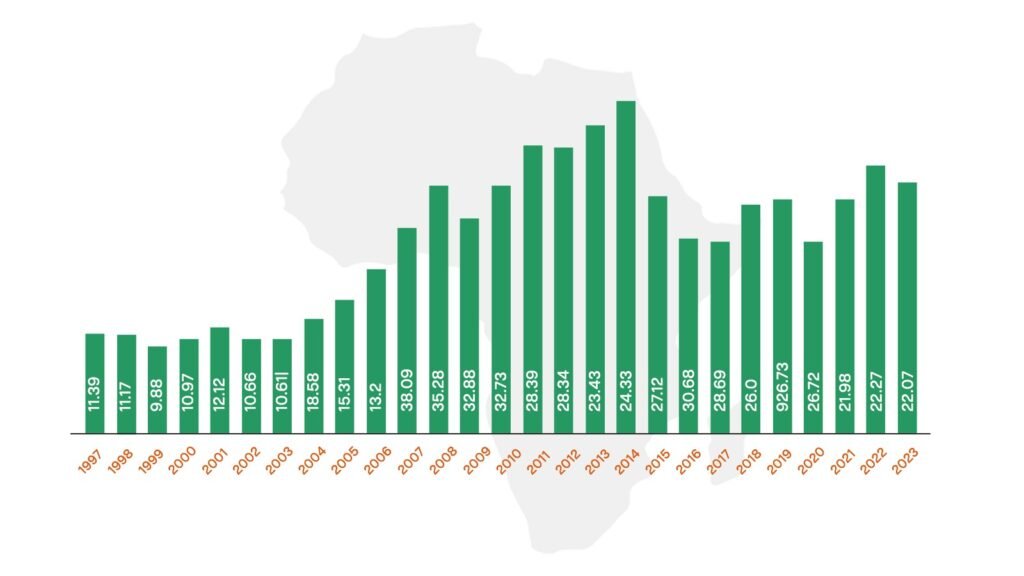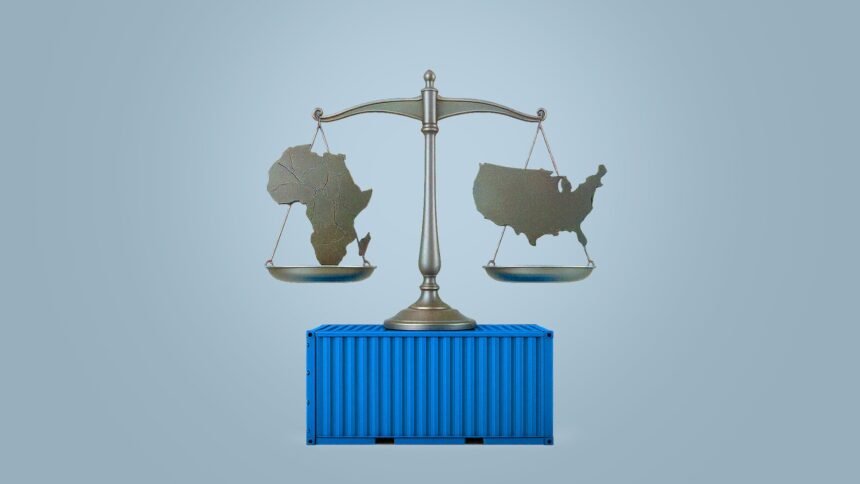In the ever-evolving landscape of global economics, the relationship between the United States and the African continent emerges as a vibrant mosaic of opportunities, challenges, and strategic partnerships. As the world’s youngest and most dynamic region, Africa embodies a spirit of resilience and innovation, where trade diplomacy serves as a vital thread weaving together aspirations for sustainable development and mutual benefit. Recent developments, including the expiration of a landmark trade agreement, underscore the need for Pan-African solidarity to navigate shifting geopolitical currents. This comprehensive examination explores the historical underpinnings, current realities, and prospective pathways of this transatlantic alliance, underscoring how diplomatic ingenuity can transform trade into a cornerstone of Pan-African empowerment and enduring prosperity.
Echoes of Legacy: The Foundations of Transatlantic Economic Bonds
The saga of US-Africa trade diplomacy begins in the twilight of the 20th century, a period marked by optimism following the end of colonial eras and the Cold War’s ideological divides. Enacted in 2000 under the administration of a forward-thinking leader, a groundbreaking initiative aimed to catalyze economic growth by granting preferential market access to qualifying African nations. This pact, rooted in principles of development and integration, sought to shift the paradigm from dependency on aid to empowerment through commerce, allowing thousands of products—from textiles to agricultural goods—to enter the American market without tariffs.
Over the past quarter-century, this framework has undergone several evolutions, with extensions in 2004, 2015, and beyond, each incorporating refinements to promote good governance, labor rights, and environmental standards. These adjustments reflected a diplomatic commitment to accountability, where eligibility hinged on progress in democratic reforms and human rights. Yet, the journey has not been without hurdles; suspensions for political instability or policy divergences have occasionally disrupted flows, prompting African nations to rally through regional organizations like the African Union for collective advocacy.
Historically, this alliance has mirrored broader global trends. In the early 2000s, trade volumes surged amid rising commodity prices, peaking at over 140 billion dollars in 2008 before receding due to economic downturns and the shale revolution in US energy production. By 2024, bilateral trade had rebounded to approximately $ 72 billion, with African exports emphasizing energy, minerals, and apparel, while US shipments focused on machinery and technology. This evolution underscores a Pan-African strategy of diversification, where nations have increasingly invested in value-added industries, fostering intra-continental synergies that strengthen diplomatic leverage.
Currents of Exchange: Mapping the Flows of Goods and Opportunities

(U.S. exports of trade goods to Africa 2023| Statista)
At the heart of US-Africa trade diplomacy lies a dynamic exchange of resources and innovations that fuels growth on both sides of the Atlantic. Recent data illustrate a trade volume that, while modest compared to Africa’s ties with Asia—nearing $ 300 billion—holds significant potential for expansion. In the first half of 2025 alone, US-Africa trade surged by 26 percent, although a persistent US deficit of around $ 4.86 billion highlights the concentration in key sectors.
African exports to the United States have traditionally been led by energy products, accounting for over half in peak years, with countries such as Nigeria and Angola dominating this sector. Non-energy sectors, however, have shown remarkable growth; textiles from Lesotho and Madagascar, fruits from South Africa, and apparel from Kenya collectively contribute billions, benefiting from duty-free privileges that enhance competitiveness. In 2024, US imports from Africa totaled $ 39.5 billion, a slight increase, with 90 percent of non-energy goods originating from just five nations.
On the import side, the United States supplies Africa with advanced machinery, vehicles, aircraft, and chemicals, supporting infrastructure projects and industrial modernization. Services trade adds another layer, encompassing financial expertise, education, and digital solutions, which have grown steadily to complement the exchange of goods.
To contextualize this trajectory:
| Year | US Imports from Africa (Billion USD) | US Exports to Africa (Billion USD) | Total Bilateral Trade (Billion USD) | Key Drivers |
| 2000 | 27.6 | 16.7 | 44.3 | Initial pact implementation; oil boom begins |
| 2008 | 113.5 | 28.2 | 141.7 | Commodity price peaks; energy dominance |
| 2015 | 34.6 | 26.0 | 60.6 | Post-recession dip; diversification efforts |
| 2020 | 23.7 | 21.8 | 45.5 | Pandemic disruptions; supply chain shifts |
| 2024 | 39.5 | 32.4 | 71.9 | Recovery with focus on minerals and tech |
| 2025 (Q1-Q2) | 22.1 | 18.4 | 40.5 | Tariff impacts emerging; services growth |
These patterns reveal a story of adaptation, where Pan-African initiatives, such as the African Continental Free Trade Area, aim to boost internal trade from 15 percent to higher levels, creating robust value chains that attract US investments in renewable energy and critical minerals.
Navigating Turbulences: Challenges and Diplomatic Crossroads in Shared Prosperity
The path of US-Africa trade diplomacy is fraught with complexities that demand nuanced navigation. The recent expiration of the preferential access framework on October 1, 2025, has cast a shadow over more than a million jobs across the continent, exacerbating vulnerabilities in export-dependent sectors. Without renewal, African economies are projected to face an 8.7 percent drop in US exports by 2029, according to projections, with low-margin industries such as apparel suffering immediate impacts.
Country-specific impacts vary starkly. Nigeria, bolstered by diversified partnerships with China and India, may weather the storm with minimal disruption, its petroleum exports cushioned by global demand. In contrast, smaller nations like Lesotho and Madagascar face severe repercussions; Lesotho’s denim sector risks 40,000 job losses in a population of 2.3 million, while Madagascar’s vanilla and textile industries threaten 60,000 positions. South Africa, the largest beneficiary, anticipates tens of thousands of layoffs in the fruit and motor industries, with car exports plummeting 85 percent amid 30 percent tariffs. Kenya faces potential losses of up to 65,000 in textiles and fruits, prompting bilateral talks during recent global assemblies.
These challenges are compounded by broader diplomatic frictions, including US tariffs that start at 10 percent universally, with higher rates applied to select nations over perceived policy misalignments. Accusations of human rights issues or geopolitical stances have led to aid cuts and threats of sanctions, as seen in South Africa’s case amid unfounded claims. Meanwhile, competition from China, which extended duty-free access to most African countries in June 2025, intensifies the need for Pan-African unity to negotiate terms that are balanced.
Yet, diplomacy offers avenues for resolution. African officials’ last-minute engagements in late September suggested a consensus for a short-term renewal, with the US administration backing a one-year extension amid domestic priorities, such as government shutdowns. Business lobbies argue that revival would diversify supply chains away from dominant players, aligning with strategic interests in countering influence and securing minerals.
Horizons of Hope: Charting Future Pathways in Pan-African Trade Alliances
Looking ahead, the future of US-Africa trade diplomacy holds promise for reinvention, where Pan-African collaboration can transform challenges into catalysts for growth. As of October 5, 2025, the expired framework remains in limbo, with bipartisan efforts in Congress pushing for extensions up to 2041; however, the immediate focus centers on averting short-term damages through temporary measures.
Strategic shifts include bilateral deals, like Kenya’s pursuits, and regional pacts that emphasize reciprocity. Investments in critical sectors—such as renewables, technology, and agribusiness—could attract billions, deconcentrating dependencies and fostering sustainable development. The US’s reaffirmed support for Moroccan sovereignty over Western Sahara, announced in late September, signals opportunities for business in the region, with commitments to back American firms in all Moroccan territories.
Parallel developments underscore the interconnectedness of trade and diplomacy. In Southern Africa, China’s $ 1.4 billion deal to revamp the Tanzania-Zambia railway, signed on September 29, rivals US-backed corridors, promising faster copper exports and highlighting the role of infrastructure in economic leverage.
Vigilant Gazes: Monitoring Emerging Diplomatic Currents Across the Continent
Beyond trade, diplomatic vigilance reveals pulsing undercurrents shaping Africa’s future. In Morocco, Gen Z-led protests, entering their eighth day by October 5, 2025, demand reforms in healthcare and education amid preparations for the 2030 FIFA World Cup. Sparked by tragic hospital deaths in Agadir, the movement has seen over 400 arrests and injuries to hundreds, with youth unemployment dipping to 35.8 percent but still fueling discontent. Demonstrators chant for hospitals over stadiums, echoing broader calls for social justice in North Africa.
In the Great Lakes region, the Democratic Republic of the Congo and Rwanda commenced implementing a US-brokered peace deal on October 1, with Rwandan troop withdrawals and joint operations against rebel groups. However, stalled talks with the M23 militia and ongoing violence temper optimism, as economic pacts remain unsigned, underscoring the fragility of diplomacy.
Ghana’s controversial third-country deportation agreement with the US, finalized in September, led to the lifting of visa restrictions on October 5. While praised for diplomatic gains, critics decry coercion via tariffs, with reports of deportees being relocated to neighboring countries without documents, straining regional ties.
Human trafficking concerns surface in Kenya, where over 20 individuals were rescued from a ring promising Moscow jobs but intending Ukraine frontline deployment. Arrests in late September, including that of a Russian national, highlight vulnerabilities amid job shortages, with investigations revealing payments of up to $ 18,000 for fraudulent schemes.
Forging Ahead: Investments and Intellectual Exchanges in Pan-African Diplomacy
Investment pulses drive diplomatic momentum, as seen in the China-Tanzania-Zambia railway revival, a 1.4 billion dollar project to modernize a 1970s-era line for efficient mineral transport. Managed by a Chinese firm for 30 years, it challenges alternative corridors, promising economic boosts for Zambia’s copperbelt.
Intellectual dialogues enrich this tapestry. Explorations of Turkish drone diplomacy in Somalia and beyond reveal strategies for energy diversification and power projection. Meanwhile, reflections on historical expeditions, like a former US leader’s 1909 safari, blend scientific legacy with controversies, contributing to natural history collections while sparking debates on conservation ethics.
Allegations of conflicts of interest in luxury dealings, involving a US advisor’s family ties during Libyan oil negotiations, raise questions of transparency in diplomacy, prompting concerns among allies about freestyle engagements in the Congo and Lebanon.
In sum, as Africa charts its course, Pan-African unity in trade and diplomacy promises a horizon where challenges forge stronger alliances, turning economic exchanges into bridges of shared destiny.










